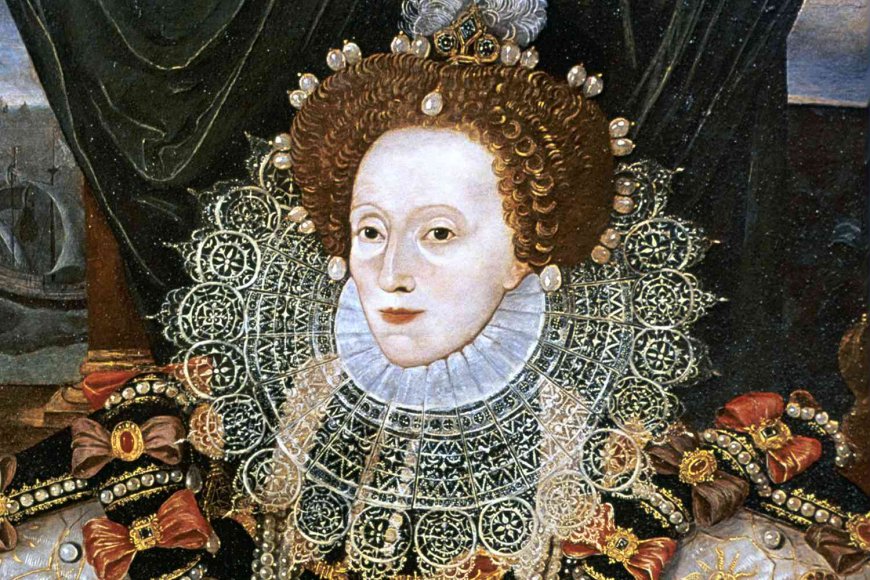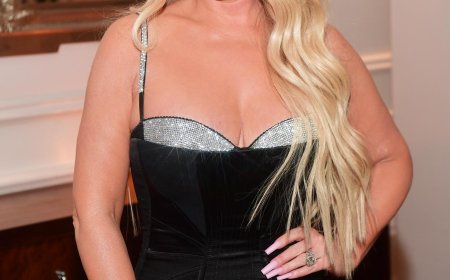The Dark Story Behind Queen Elizabeth I’s Stark White Makeup: ‘Beauty Must Suffer’
More than just a statement beauty regime, the Virgin Queen’s signature makeup was born from sad beginnings — and possibly led to a tragic ending

More than just a statement beauty regime, the Virgin Queen’s signature makeup was born from sad beginnings — and possibly led to a tragic ending Ann Ronan Pictures/Print Collector/Getty Elizabeth I, Queen of England and Ireland, c1588. Version of the Armada portrait attributed to George Gower. The last Tudor monarch, Elizabeth I (1533-1603) ruled from 1558 until 1603:max_bytes(150000):strip_icc():format(jpeg)/queen-elizabeth-i-portrait-112624-2-a06dd671768142fa921c21e9c12c93a0.jpg)
One of Queen Elizabeth I’s most well-known features was her stark white makeup — but the face painting was applied for a deeper, darker reason.
Elizabeth I’s makeup, along with the bold red wig she was known to sport, became a part of the legacy of the Queen who reigned from 1558 until her death in 1603. Why did the last monarch of the House of Tudor cake her face with heavy makeup? To cover up scars from smallpox, which she came down with in 1562 — just four years into her reign — and which almost killed her. Elizabeth’s skin was scarred from the illness, so she covered the pockmarks with heavy white makeup made of white lead and vinegar. To make the story even darker, the makeup she used to cover her smallpox scars slowly poisoned her over time.
Related: The Crushing Reason Queen Elizabeth I Caked Her Face with White Makeup
Margot Robbie portrayed Queen Elizabeth I in the 2018 movie Mary Queen of Scots — and was nearly unrecognizable in the role. The actress told PEOPLE that Elizabeth’s striking look was “something I wasn’t really expecting when signing on for the role, but I was excited by the prospect. It helps me a lot to find a character if I look completely different to how I look in real life. It makes my acting job much easier.”
Elizabeth’s makeup, Robbie said, ultimately became a part of her brutally self-disciplined persona. “We’re left with this mask-like version of a person, who is no longer a person by the end, but a throne and a representation of power in a country,” Robbie told PEOPLE. “I loved that she kind of built the mask for herself and then was inherently trapped by it.”
Mary Queen of Scots director Josie Rourke told PEOPLE, “When your skin isn’t at its best, when you’ve got a breakout, you try and cover that up. Do you feel confident enough to go into a meeting if you’ve got a gigantic blemish on your face? You can really feel her courage in really gathering herself back together again and finding the braveness to walk into these rooms.”
Elizabeth I — the daughter of King Henry VIII and his second wife, Anne Boleyn, who Henry later had beheaded in 1536 after she was charged with adultery — ascended to the throne following Queen Mary’s death in 1558. According to the royal family’s official website, her reign is generally considered the “most glorious in English history.”
A multilinguist, Elizabeth famously never married throughout her 45-year reign, instead declaring herself married to her country. Because she never married, and therefore never had children, she was known as the Virgin Queen.
“It was actually quite clever of her to announce that she was married to the country and therefore could not be married to someone else,” Robbie said of the woman she portrayed onscreen. “It was really the only way of protecting herself and protecting her position in that way. It really came from life and death stakes. In her mind, it was a survival technique.”
“I wanted to show what she sacrificed to become who she became and what she lost in order to be one of the longest reigning monarchs in history and give England one of its longest periods of peace that it ever had,” she added. “She sacrificed a lot in order to be able to do that.”
Officially, Queen Elizabeth I died at age 69 of unknown causes on March 24, 1603 — but theories persist that she may have died from blood poisoning caused by toxic ingredients in her pronounced makeup. But the makeup was a necessity, Mary Queen of Scots makeup artist Jenny Shircore told The Washington Post, as beauty and power “in those days went hand in hand,” she said. Covering her scars, therefore, allowed her to feel not just more beautiful, but more powerful.
The boils and blisters that covered Elizabeth’s face after her illness took Shircore the longest amount of time to create, and before those scenes, Robbie would sit in the makeup chair for about three hours. (It’s also worth noting that Robbie also wore a prosthetic nose for her role as Queen Elizabeth I.) After the blemishes came the scars, and Elizabeth covered them “like anyone does with a pimple,” Shircore said. As she ages, the amount of heavy makeup she cakes on increases, eventually leaving her face “as white as a sheet,” The Washington Post reported. Robbie told Harper’s Bazaar that when she walked out of her makeup trailer in full stark white makeup, her co-stars “wouldn’t even get close to me. It was very alienating.”
Related: See Margot Robbie Transform as Queen Elizabeth I in 'Mary Queen of Scots' Scene
Not so for the real Elizabeth I, as, according to The Mirror, “skin as white as snow” was “something that the English elite idolized at that time.”
Elizabeth herself addressed her smallpox scars in 1586 while addressing parliament, saying, “We princes, I tell you, are set on stages in the sight and view of all the world fully observed. The eyes of many behold our actions, a spot is soon spied in our garments, a blemish noted quickly in our doings.”
So on came the makeup — a Venetian ceruse, a cosmetic composed of white lead and vinegar, which the Queen applied to her face and neck. Lead — unsafe to be applied to skin — can lead to hair loss, skin deterioration and even death from prolonged lead poisoning, The Mirror reported. “This would have likely corroded the skin,” according to the outlet, adding, “As her skin deteriorated, it is said that she would layer on more and more, reaching a coverage that was one inch thick towards the end of her life. To make matters worse, the Queen would have her makeup applied once a week and would leave it on for the duration, allowing the lead a chance to completely soak into the skin.”
When Elizabeth had her makeup removed, historians believe that she may have used a concoction containing mercury, and side effects of being gradually poisoned by mercury include “memory loss, irritability and depression, symptoms which the Queen in fact experienced towards the end of her life,” according to The Mirror. “Not to mention that the mercury would have likely slowly eaten away at her flesh.” Ann Ronan Pictures/Print Collector/Getty Elizabeth I, Queen of England and Ireland, 1575. The Phoenix portrait attributed to Nicholas Hilliard (1537-1619). The last Tudor monarch, Elizabeth I (1533-1603) ruled from 1558 until 1603
Between lead and mercury, there were now two toxins that were “causing harm to Elizabeth and her health due to her deadly makeup regime,” The Mirror reported. The outlet added that, while Elizabeth’s cause of death is still up for debate, “the increasingly liberal doses of both lead and mercury is sure to have added to her complex ailments and certainly played a part in her declining health and subsequent death.”
“Elizabeth was acutely aware of the importance of maintaining a youthful appearance,” Sue Prichard, senior art curator at Royal Museums Greenwich, told The Mirror. “Anti-Protestant propaganda portrayed her as an aging Queen, her body corrupt and unfit for retaining the throne. Elizabeth cultivated her image using a combination of smoke and mirrors and paint, the term used for what we now call cosmetics.”
“All the ladies of the court cultivated a pale countenance,” she continued, adding that “The decision to do so had devastating consequences on their health, but at the end of the day, they considered [it] worth it.”
Can't get enough of PEOPLE's Royals coverage? Sign up for our free Royals newsletter to get the latest updates on Kate Middleton, Meghan Markle and more!
Speaking to Deadline, makeup artist Shircore said, “It was usually the case that a fashion, in those days, would stem from practical reasons, so therefore women adopted this thing of a pale skin and a white skin. The nature of makeups in those days, they contained mercury and all sorts of horrid substances that could kill you. It was beauty, and beauty must suffer.”


























































